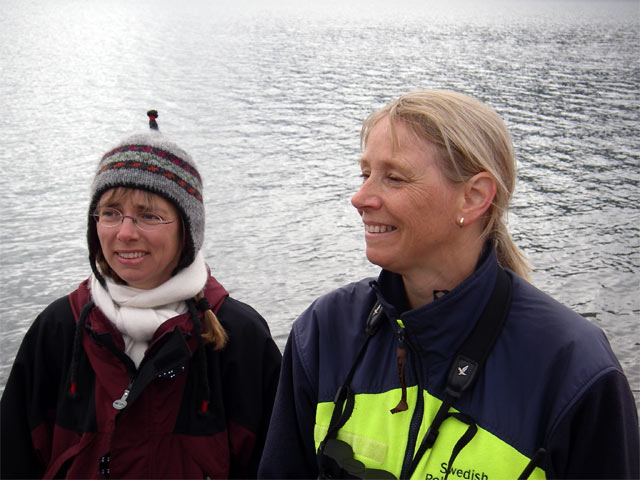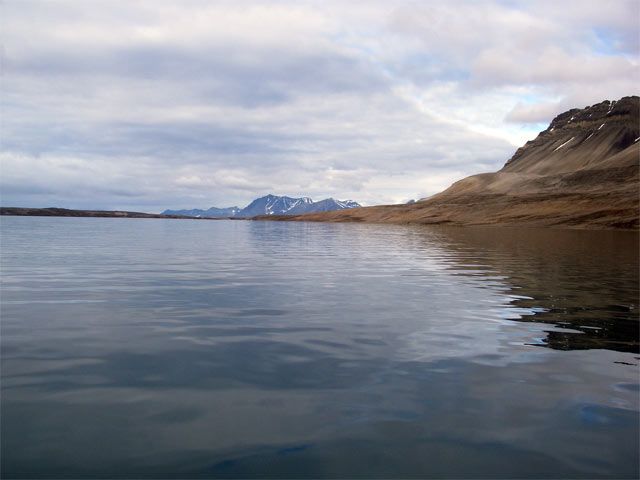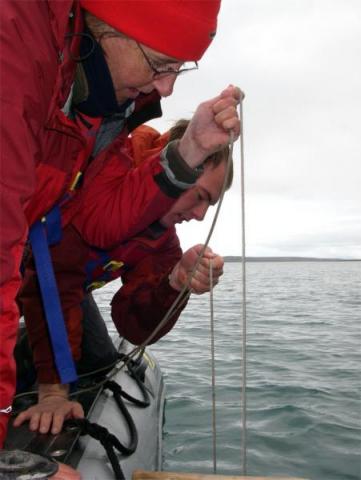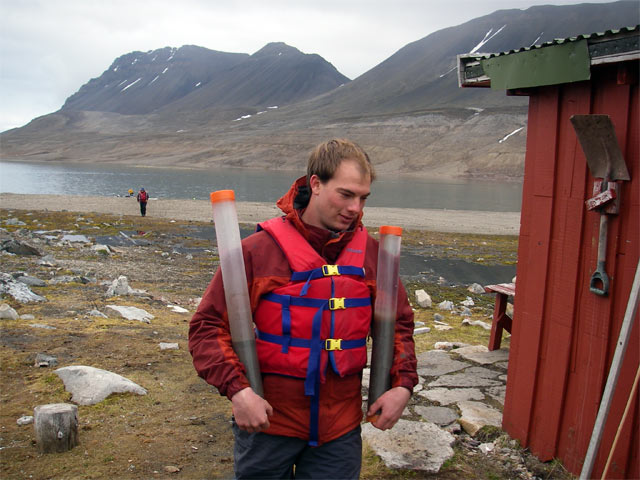( Log In ) Log In is for TREC Teachers & Researchers only
  |
| Maggie_Kane |
 Aug 10 2006, 03:24 PM Aug 10 2006, 03:24 PM
Post
#1
|
 Advanced Member    Group: TREC Team Posts: 51 Joined: 12-April 06 Member No.: 27 |
Today we needed to share one of our boats with a UNIS class that would arrive at the north end of the lake at 10:00am. We met up with Inga and Inger and made arrangements to leave them with the red boat, 7 life vests and a can of gas. Their class had come to study the geese and fish populations. We then hopped into the gray boat and traveled down to the south end of the lake.
Inger and Inga  Leif and Caroline would go up to Kongress to do some more mapping of the rock units and we would spend the day on the water hauling in some sediment traps that had been out all year, and collecting some core samples. This was a really exciting day for Heidi and Bennet. Because their projects rely heavily on studying the stratigraphy (layering) of the sediments in their collection tubes, the work will largely be done after the field season when they have access to microscopes. This has left them available to help other students with their projects, but also really anticipating this day when their samples would be collected. I wanted to be there to see how it was done, as well as share in their experience and excitement. I was not disappointed in the least! First we went to mooring G to find last years sediment traps. You might recall a few days ago (August 5) I highlighted Heidi’s project and how the sediment traps work. If you didn’t read that yet, you might find that entry really helpful. Today we would carefully pull up the filter tubes and collection funnels that were attached to a long rope anchored to the lake bottom. We used a bathymetry device (casually known as the fish finder) to locate the mooring with its PGS unit. Once we were close, the screen would show us a kind of picture of the bottom. The mooring would show up as a ghostly dangling line on the device as we passed by it, helping us locate it easily. Bathymetry Device  Then Heidi and Bennet grabbed the buoy and pulled so that the rope could run through the winch on the wooden boom of the boat. As the traps came up, Bennet would stop pulling the rope and Heidi would carefully detach the sediment traps. Heidi Guides the Rope Up Carefully  Inside the tubes, fine grained particles could be seen in clear layers. Close Up View of Sediment Tube  Heidi was really excited about this, but took her time getting them out of the water. Her hands got really cold in the glacial lake water. We held the collection tubes carefully in the boat as she collected them. We also pulled up temperature loggers that had been placed along the line. Then we pulled up the HUGE rock that had anchored the mooring. We found that the last temperature logger was tied to the underside of the rock (there is actually a really interesting data set that comes from this logger). The wind from the morning had quieted a bit and we looked at the calm lake water and knew that it was a perfect day for coring. Quiet Lake Water  To core, you need the boat to stay still on the water surface so that the core goes in vertically and so the hammer, which will be dropped by a guid rope, will hit soundly. Bennet got ready to go with his first core tube. If you haven’t read about coring, you might want to go back to August 2, and read about Caroline’s lake cores from Kongress. Time to Core  We would use the bathymetric device again to help us find the right depth and log our location into the fish finder as a “waypoint”. This could later be downloaded into the computer to map the coring location. BUT… the device appeared to not be working. The battery must have had enough, so Al took the battery (about the size of a small loaf of bread) and stuck it under his shirt. Brrrr! Batteries do not like the cold, and we hoped that warming it would help get some more life out of it. After a while, we tried again, but no luck. We had to come up with another way to record our location and depth. We had a hand held GPS unit, so we decided to use that to log our coordinates. We also used the measuring tape and tied it to a small rock with some rope. We would lower that just to the bottom and measure the height to the water surface. It was just like the good old days, and it worked just fine! Doing Things the Old Fashioned Way  When we were set, Bennet slowly reeled down the coring device with the two ropes. One was attached to the top of the corer and the other to the heavy weight that slid up and down on the core shaft. These two ropes could not get tangled or the weights would not raise and lower. It took a bunch of tries until Bennet got a good feel for the ropes. All the while Al was really patient and let him figure it out – what a great teacher! When the core was gently touching the bottom, the hammer would be carefully raised by its rope and then dropped. Here you can see me working the hammer line while Bennet holds the corer steady. Tapping In the Core  We wanted to tap in the core tube enough to fill it without going too far. Then, we wanted to gently pull it out of the mud without loosing it from the tube! There was quite a bit of suction on the tube from the muddy bottom, and it was hard to pull gently. When the tube got near the surface, we would reach into the freezing water with a cap, and close the bottom of the core. Then it was safe to pull out of the water! Bennet and Heidi worked together to get up some really great cores. Look how excited they are to have done such good work! Great Core!  They got so jazzed by the quality of the cores that they just had to cut one open and look at it, so we did. Then they had to smear mud all over their faces! This is a clear sign of too much field work! When You Are Just So Happy…  Heidi and I decided to take one more tube from over near the river outlet. We thought this might be neat to look at, but with larger grainsize, we thought it might not stay in the tube. Sure enough, we got a gorgeous core! It was so beautiful we had to take a sip (another clear sign it is time to end the field season)! A Sip of Linnevatnet!  Then it was time to collect Caroline and Leif from Knogress and store our tubes. Once they have settled a bit more we will take them home to Isfjord Radio. There, they cores will be “dewatered” for the trip home. I am really curios to see how these get transported all the way home. Storing the Cores in the South Hut  We arrived home just in time to eat an excellent dinner and get into the work room for our broadcast Webinar to my students at Prescott Mile High Middle School. They had come with EXCELLENT questions, and our whole group here enjoyed talking to them about this project. At the Webinar  We only have 3 more days in the field to collect our data, and the students are working very hard. It is hard to imagine going home in just over a week, but this place will never really leave us. Everyday is so much fun and full of many adventurous moments and learning pieces. It was quite a day. I asked the students to finish this sentence for me: You know you are really in the arctic when… Here are some of their words: “…you haven’t seen a tree since the mainland” “…you crawl under your warm quilt at midnight and curl up in a ray of warm sunshine, pouring in your window to lull you to sleep” “…you are carrying a rifle, a flare gun, a radio, a satellite phone and a complete change of clothes in your backpack” “…your eating a peanut butter, jelly and coffee grounds sandwich for lunch” “…you can’t go swimming for more than 2 seconds!” “…you don’t care anymore that there is snot streaming out your nose and flying horizontally in the wind” "...you barely remember what fresh fruit and vegtables look or taste like!" "...you mistake rolling sea foam balls for charging polar bears!" So there you have it! |
  |
1 User(s) are reading this topic (1 Guests and 0 Anonymous Users)
0 Members:

|
NSF Acknowledgment & Disclaimer | Time is now: 16th November 2024 - 01:18 PM |
Invision Power Board
v2.1.7 © 2024 IPS, Inc.








